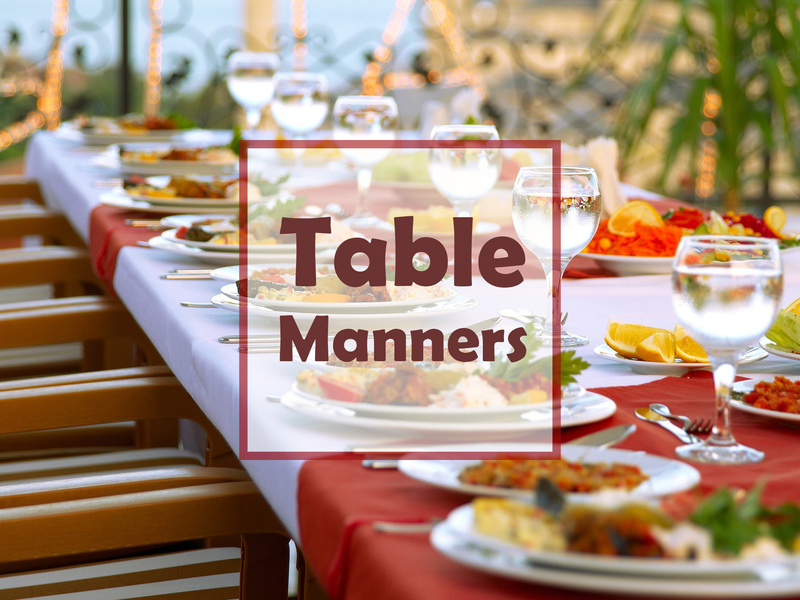
The Family Dinner Ritual: Part 2 – Table Manners
As the autumn leaves fall, my attention starts turning towards preparations for the holidays – with warm family gatherings, traditional foods, and a well-decorated table. My mother had always put her artistic energy into creating a beautiful holiday table, with red and orange table linens, and a handmade centerpiece she designed with foliage and flowers from her garden. As I evolve my own family traditions, I realize how much time and thought my mother put into making the holidays special with the place settings, traditional recipes, and starting the dinner by giving thanks. The holidays are indeed a good time to be creative, heighten the dining experience, and be part of a bigger tradition many people are celebrating together with their families.
Part of that celebration is ensuring everyone is comfortable. The goal of Dining Etiquette is to provide a set of guidelines that enable everyone to be more comfortable, or at least less confused at the table, and ensure the focus can stay on both the meal and the company. Table Manners show others how you choose to apply the etiquette guidelines, how you behave, and how you show respect and kindness to one-another.
In Part 1 of this series for the Issaquah Daily, the focus was on the Table Setting. Once you have a set table, you can layer on the basics on table etiquette, to be used at a holiday gathering or when dining out. After all, every one of us can benefit from a brush-up on good manners!
Seating. In a more formal setting, each guest would stand to the right of their chair while awaiting the host or hostess’ invitation to be seated. Guests would then sit down from the right side of the chair, leading with their left leg, to ensure no one bumps into one-another.
Napkins. At a formal dinner, once the host/hostess places their napkin in their lap, you may follow with your own napkin. Otherwise, place your napkin in your lap when you are seated. Fold the napkin in half and place it across your lap. Dab the corners of your mouth with the inside of your folded napkin, to avoid soiling your clothing or seat. When excusing yourself from the table, you may place your napkin in your seat. When finished, neatly place your napkin left of your plate.
Eating. Wait to start the meal until the host or hostess begins, signaling the start of the meal, unless the host indicates for everyone to ‘please go ahead.’ The guideline is generally to wait until the host is seated for parties smaller than 10 people.
Toasts. It is common for the host or hostess to welcome everyone by raising a glass. If there is a guest of honor, the host may say a few words about the guest as the dinner progresses. The person being toasted does not drink to their own toast, however all other guests may raise their glass. Many cultures make eye contact and nod slightly to each person around the table before sipping their drink. You may also choose to clink glasses barrel to barrel to avoid breakage.
Silverware. The appropriate silverware will be set based on the number of courses. Always use the outside silverware first, starting with the salad fork on the far left, if salad is the first course. A soup spoon will be placed to the right of the knife if soup is being served. Once silverware is used, always place it on your plate to avoid soiling the table. When finished, place your silverware in parallel, diagonally across your plate at the 10:20 position. This indicates that you are finished with your meal. It is most polite to wait until all guests are finished before plates are removed, so no one feels rushed.

Photo Credit: Etiquettepedia
Bread. Your Bread Plate is above your fork. A helpful way to remember which bread plate is yours by forming a B and D with your fingers, “B” for Bread and “D” for Drink, as indicated in the drawing below. Place a small amount of butter on your plate, and tear one small piece of bread at a time, applying butter to each piece.

Photo Credit: John Kau
Passing. Rather than reaching across the table, ask for someone to ‘please pass’ what you would like. When passing dishes, always pass counterclockwise, to ensure people can receive with the right hand. Always pass the salt and pepper together to avoid having to pass twice.
Gestures. Avoid pointing with your fingers or silverware. Although it is appropriate to rest your wrists on the table edge, avoid placing your elbows on the table. Keep your mouth closed when chewing, and avoid scraping your silverware on the plate for anyone with sound sensitivities, such as hearing aids.
The holidays are a wonderful time to celebrate family and friendships, and create memorable traditions and memories across the generations. Knowing the etiquette enhances the experience for everyone, and teaches younger guests how to dine with less confusion and more confidence.
Article content provided by Daily Etiquette founder and author, Nancy Hoogenboom. Author and Issaquah Resident Heather Andersen is a Certified Etiquette Trainer with the International Etiquette Trainers Society.
No goods or services were provided in exchange for this article.





